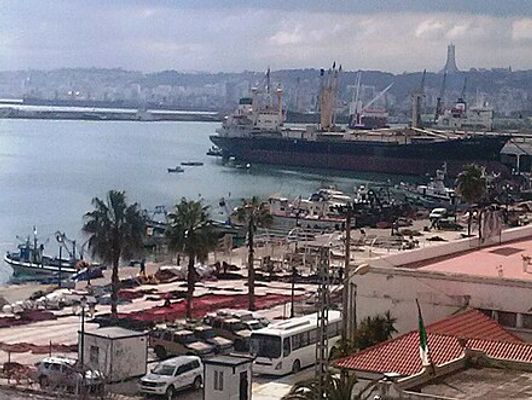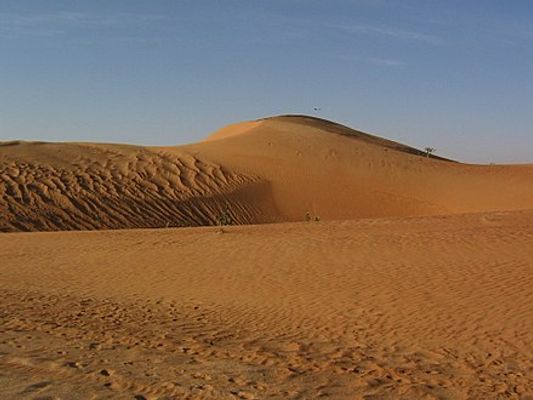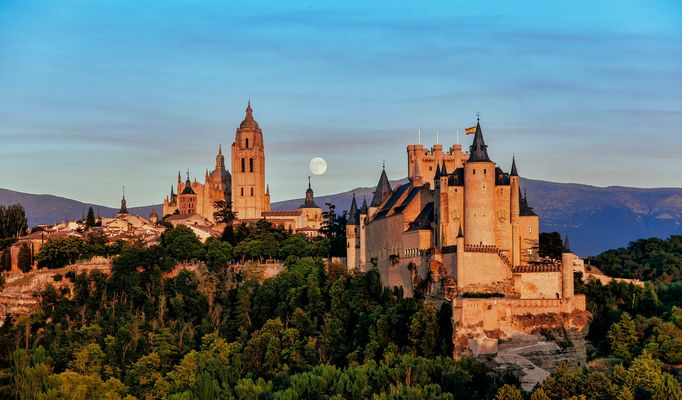
From Wikipedia: Morocco (Arabic: المغرب Al-Maghrib; Berber: ⵍⵎⴰⵖⵔⵉⴱ Elmaɣrib) is a kingdom in North Africa, at the Atlantic Ocean and the Mediterranean Sea. Morocco has 34 million inhabitants, and a rich heritage from the Islamic Golden Age. For Europeans, Morocco has been, and remains, the gateway to Africa.
find another country
Who's been?
 #??
#?? #49
#49

Nearby countries
International Airports: AGA CMN FEZ RAK NDR OZZ OUD RBA TNG TTU VIL EUN

Note to self

The rock heritage of Southeastern Morocco

The prehistoric heritage of Morocco is primarily found in the Draa Valley, with numerous sites of rock engravings. [image from Southeast-morocco.com]

Fez Festival of World Sacred Music
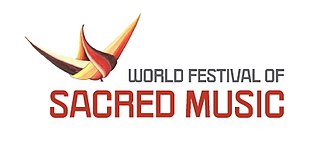
[from en.wikipedia.org]: The Fez Festival of World Sacred Music is an annual music festival that is held for a week in Fez, Morocco. It was first held in 1994 and usually held over 10 days in early June. The festival includes concerts, debates, and joint performances of Muslim and Christian devotional music from artists from all over the world.

Atlas Mountains
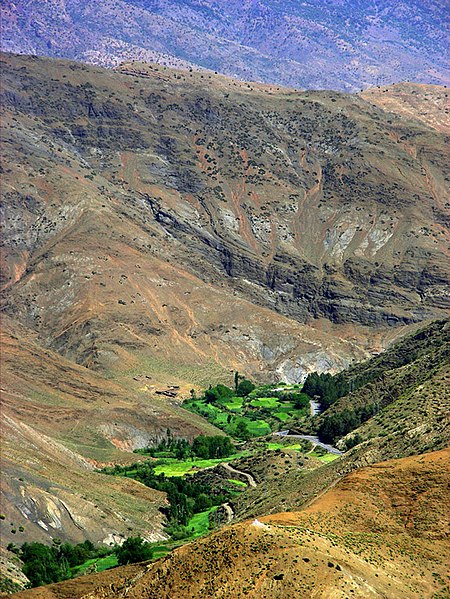
[from en.wikipedia.org]: The Atlas Mountains are a mountain range in the Maghreb in North Africa. It separates the Sahara Desert from the Mediterranean Sea and the Atlantic Ocean; the name "Atlantic" is derived from the mountain range, which stretches around 2,500 km (1,600 mi) through Morocco, Algeria and Tunisia. The range's highest peak is Toubkal, which is in central Morocco, with an elevation of 4,167 metres (13,671 ft). The Atlas Mountains are primarily inhabited by Berber populations.

Rabat
Average temperatures
Jan
17.2°C8Precipitation: 77.2 mm
Feb
17.7°C8.6Precipitation: 74.1 mm
Mar
19.2°C9.2Precipitation: 60.9 mm
Apr
20°C10.4Precipitation: 62 mm
May
22.1°C12.7Precipitation: 25.3 mm
Jun
24.1°C15.4Precipitation: 6.7 mm
Jul
26.8°C17.6Precipitation: 0.5 mm
Aug
27.1°C17.7Precipitation: 1.3 mm
Sep
26.4°C16.7Precipitation: 5.7 mm
Oct
24°C14.1Precipitation: 43.6 mm
Nov
20.6°C11.1Precipitation: 96.7 mm
Dec
17.7°C8.7Precipitation: 100.9 mm

Agadir
Average temperatures
Jan
20.4°C7.9Precipitation: 45.5 mm
Feb
21°C9.4Precipitation: 42.4 mm
Mar
22.4°C10.9Precipitation: 31.1 mm
Apr
21.9°C12Precipitation: 25.9 mm
May
23.2°C14.2Precipitation: 3.5 mm
Jun
24°C16.4Precipitation: 1.1 mm
Jul
26.1°C18Precipitation: 0.1 mm
Aug
26.1°C18.2Precipitation: 0.2 mm
Sep
26.4°C17.3Precipitation: 3 mm
Oct
25.3°C15.2Precipitation: 25.8 mm
Nov
23.5°C12.3Precipitation: 52.6 mm
Dec
20.7°C8.5Precipitation: 60.7 mm

Casablanca
Average temperatures
Jan
17°C9Precipitation: 63 mm
Feb
18°C10Precipitation: 45 mm
Mar
20°C12Precipitation: 40 mm
Apr
20°C13Precipitation: 35 mm
May
22°C16Precipitation: 15 mm
Jun
24°C19Precipitation: 3 mm
Jul
26°C21Precipitation: 1 mm
Aug
26°C21Precipitation: 1 mm
Sep
26°C20Precipitation: 12 mm
Oct
24°C17Precipitation: 45 mm
Nov
21°C13Precipitation: 82 mm
Dec
19°C11Precipitation: 70 mm

Fez
Average temperatures
Jan
15.1°C3.7Precipitation: 72.2 mm
Feb
16.5°C5Precipitation: 100.4 mm
Mar
18.3°C5.9Precipitation: 93.6 mm
Apr
19.7°C7.6Precipitation: 87.7 mm
May
23.9°C10.2Precipitation: 53 mm
Jun
28.5°C13.4Precipitation: 24.4 mm
Jul
33.9°C16.7Precipitation: 3 mm
Aug
33.8°C17Precipitation: 3.6 mm
Sep
30.4°C15Precipitation: 17 mm
Oct
24.7°C11.4Precipitation: 62.3 mm
Nov
19.3°C7.7Precipitation: 89.1 mm
Dec
15.7°C4.6Precipitation: 85.2 mm

Marrakech
Average temperatures
Jan
18.4°C5.9Precipitation: 32.2 mm
Feb
19.9°C7.6Precipitation: 37.9 mm
Mar
22.3°C9.4Precipitation: 37.8 mm
Apr
23.7°C11Precipitation: 38.8 mm
May
27.5°C13.8Precipitation: 23.7 mm
Jun
31.3°C16.3Precipitation: 4.5 mm
Jul
36.8°C19.9Precipitation: 1.2 mm
Aug
36.5°C20.1Precipitation: 3.4 mm
Sep
32.5°C18.2Precipitation: 5.9 mm
Oct
27.5°C14.7Precipitation: 23.9 mm
Nov
22.2°C10.4Precipitation: 40.6 mm
Dec
18.7°C6.5Precipitation: 31.4 mm

Meknes
Average temperatures
Jan
15.3°C5.2Precipitation: 89.4 mm
Feb
16.6°C6.3Precipitation: 84.4 mm
Mar
18.6°C7.2Precipitation: 78.4 mm
Apr
20°C8.8Precipitation: 74.3 mm
May
23.8°C11.5Precipitation: 42.6 mm
Jun
27.8°C14.6Precipitation: 12.5 mm
Jul
32.7°C17.7Precipitation: 2.1 mm
Aug
32.6°C17.9Precipitation: 1.9 mm
Sep
29.6°C16.2Precipitation: 14.1 mm
Oct
24.5°C12.8Precipitation: 47.4 mm
Nov
19.3°C9.1Precipitation: 79.6 mm
Dec
15.6°C5.8Precipitation: 81.2 mm

Ouarzazate
Average temperatures
Jan
16.6°C1.9Precipitation: 13 mm
Feb
19.3°C4.5Precipitation: 13.1 mm
Mar
22.2°C7.4Precipitation: 7.4 mm
Apr
25.1°C10Precipitation: 7.4 mm
May
29.6°C13.8Precipitation: 7 mm
Jun
34.1°C17.7Precipitation: 2.1 mm
Jul
37.8°C21.3Precipitation: 1.4 mm
Aug
37°C20.7Precipitation: 5.1 mm
Sep
32.2°C17.1Precipitation: 13.3 mm
Oct
26.5°C12.3Precipitation: 13.4 mm
Nov
20.4°C6.9Precipitation: 19.3 mm
Dec
16.7°C2.4Precipitation: 9.7 mm

Tangier
Average temperatures
Jan
16°C8Precipitation: 104 mm
Feb
17°C9Precipitation: 99 mm
Mar
18°C10Precipitation: 72 mm
Apr
19°C11Precipitation: 62 mm
May
22°C13Precipitation: 37 mm
Jun
25°C16Precipitation: 14 mm
Jul
28°C19Precipitation: 2.1 mm
Aug
29°C19Precipitation: 2.5 mm
Sep
27°C18Precipitation: 15 mm
Oct
24°C16Precipitation: 65 mm
Nov
20°C12Precipitation: 135 mm
Dec
17°C10Precipitation: 129 mm

Essaouira
Average temperatures
Jan
18.1°C11.2Precipitation: 51.5 mm
Feb
18.2°C11.9Precipitation: 37.4 mm
Mar
18.7°C12.8Precipitation: 39.5 mm
Apr
18.7°C13.4Precipitation: 34.9 mm
May
19.5°C14.9Precipitation: 8.5 mm
Jun
20.6°C16.5Precipitation: 1.6 mm
Jul
21.3°C17.2Precipitation: 0.1 mm
Aug
21.6°C17.4Precipitation: 1 mm
Sep
22.1°C17.4Precipitation: 3.1 mm
Oct
21.7°C16.4Precipitation: 25.3 mm
Nov
20.3°C14.4Precipitation: 72.7 mm
Dec
18.7°C11.8Precipitation: 65 mm

Tinerhir
Average temperatures
Jan
19°C4Precipitation: 25 mm
Feb
24°C5Precipitation: 9 mm
Mar
30°C10Precipitation: 35 mm
Apr
36°C12Precipitation: 19 mm
May
40°C16Precipitation: 5 mm
Jun
45°C21Precipitation: 2 mm
Jul
44°C22Precipitation: 3 mm
Aug
45°C20Precipitation: 8 mm
Sep
38°C18Precipitation: 37 mm
Oct
33°C13Precipitation: 28 mm
Nov
25°C7Precipitation: 67 mm
Dec
19°C5Precipitation: 14 mm

Tétouan
Average temperatures
Jan
16.8°C9.7Precipitation: 118 mm
Feb
17.1°C9.3Precipitation: 116 mm
Mar
18.6°C10.8Precipitation: 114 mm
Apr
21°C12Precipitation: 45 mm
May
23.4°C14.6Precipitation: 38 mm
Jun
26.4°C17.6Precipitation: 26 mm
Jul
29.5°C19.7Precipitation: 1 mm
Aug
30.1°C20.5Precipitation: 1 mm
Sep
27.7°C18.7Precipitation: 19 mm
Oct
24°C15.6Precipitation: 54 mm
Nov
19.7°C11.5Precipitation: 125 mm
Dec
17.1°C10.2Precipitation: 140 mm

Moulay Idriss
Average temperatures
Jan
14°C6Precipitation: 93 mm
Feb
17°C6Precipitation: 71 mm
Mar
20°C8Precipitation: 111 mm
Apr
25°C10Precipitation: 81 mm
May
30°C14Precipitation: 23 mm
Jun
35°C16Precipitation: 6 mm
Jul
39°C18Precipitation: 2 mm
Aug
39°C20Precipitation: 1 mm
Sep
35°C16Precipitation: 38 mm
Oct
28°C14Precipitation: 63 mm
Nov
21°C9Precipitation: 144 mm
Dec
14°C7Precipitation: 61 mm

Chefchaouen
No climate information available.

Merzouga
No climate information available.

M'Hamid
No climate information available.

Volubilis
No climate information available.





